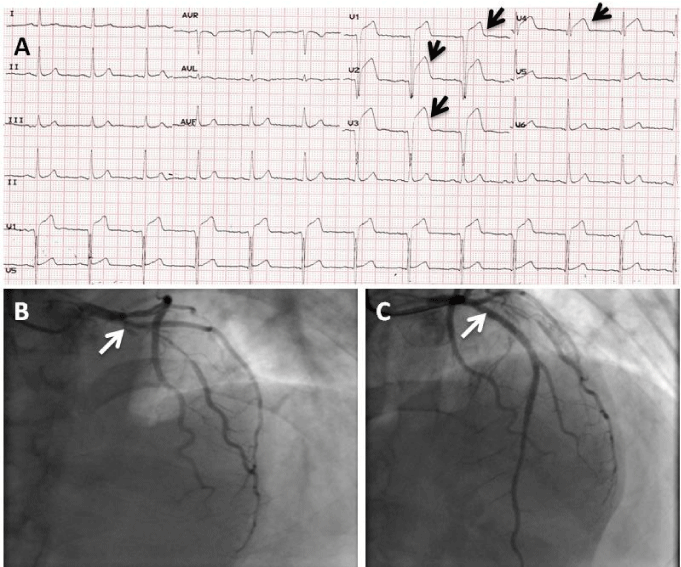Acute Myocardial Infarction could Induce Aortic Dissection?
Jiang Y. Wang*, Xi Su, Chen W. Liu, Chen YiXu, Zhi P. Zhang, Dan Song, Jian Peng and Hua Yan
Department of cardiology, Wuhan Asia heart hospital, Wuhan, China
*Address for Correspondence: Xi Su, Department of Cardiology, Wuhan Asia heart hospital, Wuhan 430022, China; Tel: +8615172496706; E-mail: [email protected]
Submitted: 13 April 2017; Approved: 26 April 2017; Published: 29 April 2017
Citation this article: Su X, Wang JY, Liu CW, YiXu C, Zhang ZP, et al. Acute Myocardial Infarction could Induce Aortic Dissection. Int J Cardiovasc Dis Diagn. 2017;2(1): 001-003.
Copyright: © 2017 Su X, et al. This is an open access article distributed under the Creative Commons Attribution License, which permits unrestricted use, distribution, and reproduction in any medium, provided the original work is properly cited
Keywords: Acute myocardial infarction; Aortic dissection
Download Fulltext PDF
A 52-year-old man with a medical history of hypertension presented to the emergency department with persistent chest pain of 6hours’ duration. Electrocardiography performed on arrival revealed anterior ST elevation. He was referred to the cardiac catheterization laboratory for Primary Percutaneous Coronary Intervention (PPCI). The coronary angiogram revealed total proximal Left Anterior Descending Artery (LAD) occlusion. The LAD stenosis was successfully treated with a drug-eluting stent. He experienced extreme thoraco abdominal pain within six hours after PPCI. Thoracoabdominalaortic Computed Tomography Angiography (CTA) was performed to rule out an aortic dissection. Eventually, the patient was successfully treated with endovascular graft exclusion.
Case Presentation
A 52-year-old man with a medical history of hypertension, morbid obesity, and a 30 years smoking history presented to the emergency department of Wuhan Asia heart hospital with a recent onset of chest pain. On the electrocardiogram at emergency room, signs of acute myocardial infarction in the anterior territory were presented with ST elevation in leads V1 to V6 (Figure 1A). Troponin I concentration was 15.28 ng per milliliter (reference range, 0 to 0.04 ng per milliliter). The transthoracic echocardiogram demonstrated the anterior wall motion abnormality, aortic valve mild regurgitation, no signs of aortic dissection. He was referred to the cardiac catheterization laboratory for primary percutaneous coronary intervention. The coronary angiogram revealed total proximal left anterior descending artery occlusion (Figure1B). The LAD stenosis was successfully treated with a drug-eluting stent (Figure 1C).
He experienced extreme thoracoabdominal pain within six hours after PPCI. At the time his vital signs included temperature 37.2°C, heart rate 103 beats/min, blood pressure 196/100 mmHg, and respiratory rate 22 breaths/min, there was not a thoracoabdominal bruit. Thoracoabdominal CT angiography was performed to rule out an aortic dissection. CTA revealed a dissection in the descending thoracic aortic arch, abdominal aorta and involved in left renal artery (Stanford B) (Figure 2A,B). Eventually, the patient was successfully treated with endovascular graft exclusion (Figure 2C).
A total of 988 Aortic Dissection (AD) patients in nine different studies found that Acute Myocardial Infarction (AMI) was present in 7% of cases [1]. The relation between AMI and AD is important because of the potential hazards in clinical practice: the wrong decision will result in a higher mortality rate [1]. It is now recognized that AD may cause AMI [2]. Mechanisms by which AD may cause AMI are numerous: compression (by false lumen) [3]; ostium obstruction (by intimal flap) [4]; avulsion [2]; coronary artery spasm [5].
AD can undoubtedly cause AMI. Combined with this case, it seems very probable that vice versa also is true: AMI is capable of causing AD. Just as professor Goran P. Koracevic [6], said that stress in AMI (due to pain and dyspnea for example) can cause hypertensive crisis, tachycardia and an increase in the velocity of ventricular contraction (dP/dt), which are recognized mechanisms of AD pathogenesis, and an iatrogenic component in AMI (PCI, antithrombotic) may contribute to the development of AD. To our knowledge, this is the first time that AMI can induce AD. This discovery provides direct evidence for a novel complication of AMI, and lays out a foundation for AMI-induced AD intervention.
- Hiratzka LF, Bakris GL, Beckman JA, Bersin RM, Carr VF, Casey DE Jr, et al. ACCF/AHA/AATS/ACR/ASA/SCA/SCAI/SIR/STS/SVM guidelines for the diagnosis and management of patients with Thoracic Aortic Disease. Circulation. 2010; 121: 266-369. https://goo.gl/wRFaw1
- Goran KP. Suggestion to list acute aortic dissection as a possible cause of type 2 myocardial infarction (according to the universal definition).Eur Heart J. 2008; 29: 2819-20. https://goo.gl/G4ZcHb
- Ashida K, Arakawa K, Yamagishi T, Tahara T, Ayaori M, Miyazaki K, et al. A case of aortic dissection with transient ST-segment elevation due to functional left main coronary artery obstruction. JpnCirc J. 2000; 64: 130-4. https://goo.gl/Vyd5WU
- Chen A, Ren X. Aortic Dissection Manifesting as ST-Segment-Elevation Myocardial Infarction. Circulation.2015; 131: 503-4. https://goo.gl/nPP8Dx
- Chamnarnphol N, Cheewatanakornkul S, Wisaratapong T. Coronary spasm due to type A aortic dissection complicated by hemopericardium: a case report of another possible cause of coronary malperfusion. Intern Med. 2010; 49: 829–31. https://goo.gl/QW2ipp
- Koracevic GP. Acute myocardial infarction might cause aortic dissection. Resuscitation.2010; 81: 1740. https://goo.gl/hMl5TX



Sign up for Article Alerts